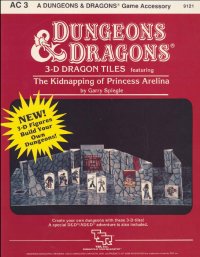But I'm pretty sure they're very very wrong, and that all the videogamisms they decry are all things D&D invented in the 70's. I'm starting this thread to just gather all the videogamisms of D&D into one handy reference, and you guys know a lot more than I do so I'll need your help to flesh it out.
Dividing the world up into level appropriate challenges
Tons of modules come with a level range, so chances are you're going to be killing hill giants then level up to kill stone giants then level up to kill frost giants then level up to kill fire giants and then level up to kill cloud giants, like how RPGs tend to lay out the worldmap.
Grid based gaming
D&D has wargaming roots so I imagine before the grid there came measuring, right? Did Dave and Gary suggest using percise measurements? Did they suggest using grids?
Did TSR encourage the use of grids and the purchasing of miniatures? I'm looking for exact dates/products if possible but I've found stuff like this module that encourages you to use dungeon terrain and miniatures.

Tournament play to beat modules
I've heard of D&D tournament play in its formative years, but when was the first one, did Gary and Dave encourage this? How did these tournaments lay out rules for character creation, item aquisition and so on? I've read on TGD that people would migrate their characters and loot like they're joining an MMORPG public raid group.
Modules built to be Nintendo Hard
http://grognardia.blogspot.com/2008/09/ ... rrors.html
This grognardia article talks about how D&D modules were made with the mindset of videogames (before videogames existed), in that you wanted to 'beat' the dungeon and if you failed you kept on trying at it until you won. Tomb of Horrors was made to be Nintendo Hard so players would get longevity out of the module, playing it over and over until they could beat it. Are there quotes from Dave n' Gary about their design philosophy?
Are there any other elements of D&D today that grognards decry as "videogamey" when they've been in D&D since the beginning?